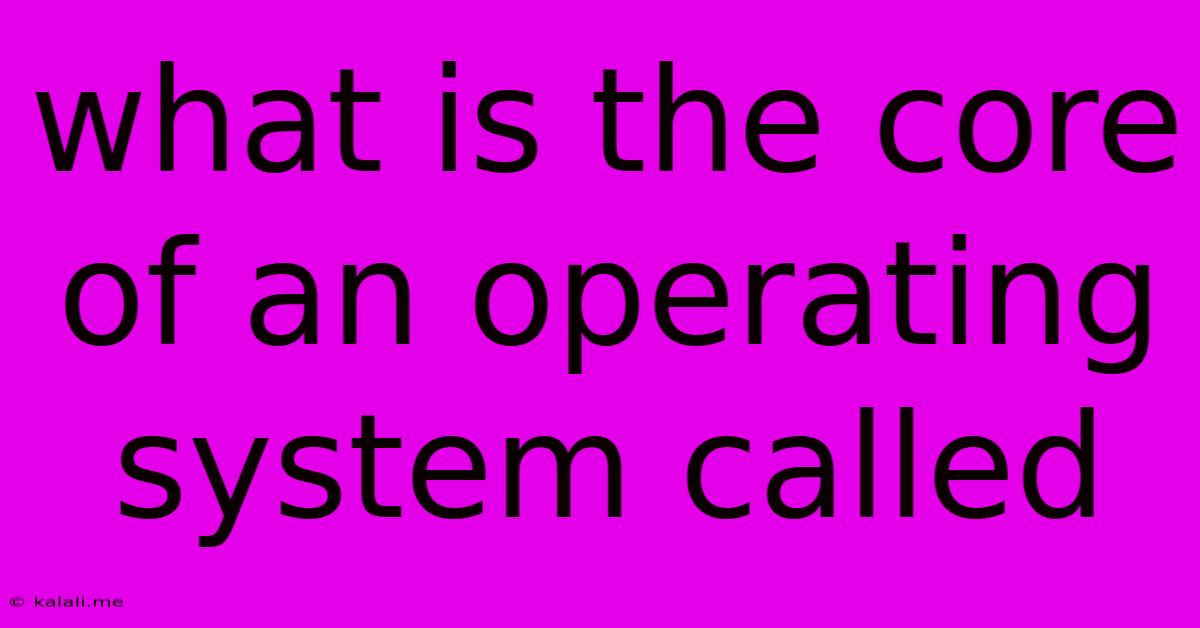What Is The Core Of An Operating System Called
Kalali
Jun 12, 2025 · 3 min read

Table of Contents
What is the Core of an Operating System Called? Understanding the Kernel
What's the heart of your computer's operating system? The answer is the kernel. This article will delve into what a kernel is, its crucial role, and why understanding it is important for anyone interested in computing. This fundamental component manages system resources, allowing applications and hardware to interact seamlessly.
The kernel is the core of an operating system. It's the lowest level of software that directly interacts with the computer's hardware. Think of it as the central nervous system of your computer, responsible for managing all the essential functions that allow other programs to run. Without a kernel, your operating system – and your computer – wouldn't function.
Key Functions of the Kernel
The kernel's responsibilities are vast and crucial for a computer's operation. Here are some key functions:
- Memory Management: The kernel allocates and manages computer memory, ensuring that different processes have access to the resources they need without interfering with each other. This prevents crashes and ensures stability. This includes techniques like paging and virtual memory.
- Process Management: The kernel controls the execution of processes, managing their creation, scheduling, and termination. It determines which process gets to use the CPU at any given time, ensuring fairness and efficient resource allocation. This involves concepts like process states and scheduling algorithms.
- Device Management: The kernel interacts with hardware devices, such as the hard drive, keyboard, mouse, and network card. It provides a consistent interface for applications to access these devices, abstracting away the complexities of hardware interaction. This includes drivers and device controllers.
- File System Management: The kernel manages the file system, allowing applications to store and retrieve data efficiently. This involves organizing files and directories, handling file access permissions, and ensuring data integrity.
- Security: The kernel plays a crucial role in maintaining system security by controlling access to system resources and enforcing security policies. It acts as a gatekeeper, protecting the system from malicious software.
Types of Kernels
Different operating systems utilize different kernel designs, each with its own strengths and weaknesses. Some common types include:
- Monolithic Kernels: These kernels are structured as a single, large program. While simpler to design, they can become complex and difficult to maintain as the system grows.
- Microkernels: These kernels provide a minimal set of services, with other operating system functionalities implemented as separate processes. This design improves modularity and security but can lead to performance overhead due to inter-process communication.
- Hybrid Kernels: These kernels combine elements of both monolithic and microkernel designs, attempting to leverage the advantages of both approaches while mitigating their disadvantages. Many modern operating systems utilize a hybrid approach.
Why Understanding the Kernel Matters
Understanding the kernel provides a deeper appreciation of how your operating system and computer work. This knowledge is particularly valuable for:
- System Administrators: They need to understand the kernel to troubleshoot system issues, optimize performance, and ensure security.
- Software Developers: A strong understanding of kernel interactions is essential for writing efficient and stable applications.
- Security Professionals: Knowledge of the kernel is crucial for identifying and mitigating security vulnerabilities.
In conclusion, the kernel is the core of an operating system, a vital component responsible for managing system resources and enabling applications to run. Understanding its functions and different types is key for anyone seeking a comprehensive understanding of computer systems.
Latest Posts
Latest Posts
-
Which Earthquake Waves Are The Fastest
Jun 13, 2025
-
Router Works In Which Layer Of Osi Model
Jun 13, 2025
-
Choose The Correct Html Tag For The Largest Heading
Jun 13, 2025
-
What Is The Difference Between Sodium Bicarbonate And Sodium Carbonate
Jun 13, 2025
-
Which Of The Following Is Not An Antibiotic
Jun 13, 2025
Related Post
Thank you for visiting our website which covers about What Is The Core Of An Operating System Called . We hope the information provided has been useful to you. Feel free to contact us if you have any questions or need further assistance. See you next time and don't miss to bookmark.